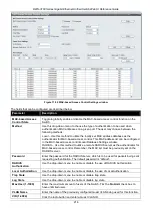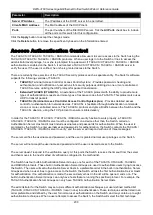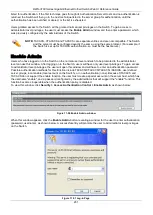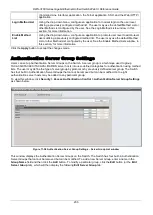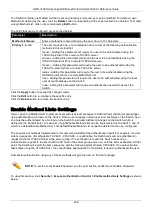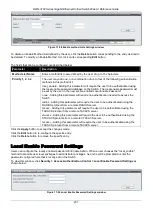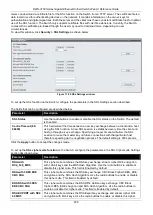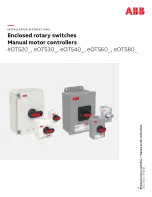
DWS-3160 Series Gigabit Ethernet Unified Switch Web UI Reference Guide
230
Parameter
Description
Server IP Address
The IP address of the DHCP server to be permitted.
Client’s MAC Address
The MAC address of the DHCP client.
Ports
The port numbers of the filter DHCP server. Tick the
All Ports
check box to include
all the ports on this switch for this configuration.
Click the
Apply
button to accept the changes made.
Click the
Delete
button to remove the specific entry based on the information entered.
Access Authentication Control
The TACACS / XTACACS / / RADIUS commands allow users to secure access to the Switch using the
TACACS / XTACACS / / RADIUS protocols. When a user logs in to the Switch or tries to access the
administrator level privilege, he or she is prompted for a password. If TACACS / XTACACS / / RADIUS
authentication is enabled on the Switch, it will contact a TACACS / XTACACS / / RADIUS server to
verify the user. If the user is verified, he or she is granted access to the Switch.
There are currently three versions of the TACACS security protocol, each a separate entity. The Switch's software
supports the following versions of TACACS:
•
TACACS
(Terminal Access Controller Access Control System) - Provides password checking and
authentication, and notification of user actions for security purposes utilizing via one or more centralized
TACACS servers, utilizing the UDP protocol for packet transmission.
•
Extended TACACS (XTACACS)
- An extension of the TACACS protocol with the ability to provide more
types of authentication requests and more types of response codes than TACACS. This protocol also uses
UDP to transmit packets.
•
(Terminal Access Controller Access Control System plus
) - Provides detailed access
control for authentication for network devices. is facilitated through Authentication commands
via one or more centralized servers. The protocol encrypts all traffic between the Switch and the
daemon, using the TCP protocol to ensure reliable delivery
In order for the TACACS / XTACACS / / RADIUS security function to work properly, a TACACS /
XTACACS / / RADIUS server must be configured on a device other than the Switch, called an
Authentication Server Host and it must include usernames and passwords for authentication. When the user is
prompted by the Switch to enter usernames and passwords for authentication, the Switch contacts the TACACS /
XTACACS / / RADIUS server to verify, and the server will respond with one of three messages:
The server verifies the username and password, and the user is granted normal user privileges on the Switch.
The server will not accept the username and password and the user is denied access to the Switch.
The server doesn't respond to the verification query. At this point, the Switch receives the timeout from the server
and then moves to the next method of verification configured in the method list.
The Switch has four built-in Authentication Server Groups, one for each of the TACACS, XTACACS,
and RADIUS protocols. These built-in Authentication Server Groups are used to authenticate users trying to access
the Switch. The users will set Authentication Server Hosts in a preferable order in the built-in Authentication Server
Groups and when a user tries to gain access to the Switch, the Switch will ask the first Authentication Server Hosts
for authentication. If no authentication is made, the second server host in the list will be queried, and so on. The
built-in Authentication Server Groups can only have hosts that are running the specified protocol. For example, the
TACACS Authentication Server Groups can only have TACACS Authentication Server Hosts.
The administrator for the Switch may set up six different authentication techniques per user-defined method list
(TACACS / XTACACS / / RADIUS / local / none) for authentication. These techniques will be listed in an
order preferable, and defined by the user for normal user authentication on the Switch, and may contain up to eight
authentication techniques. When a user attempts to access the Switch, the Switch will select the first technique

